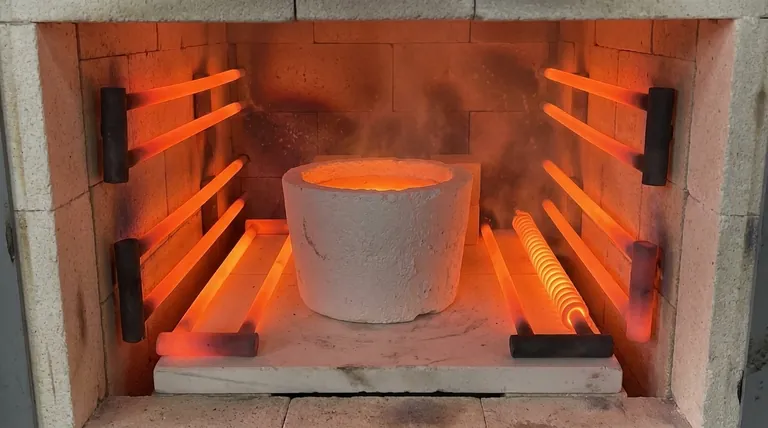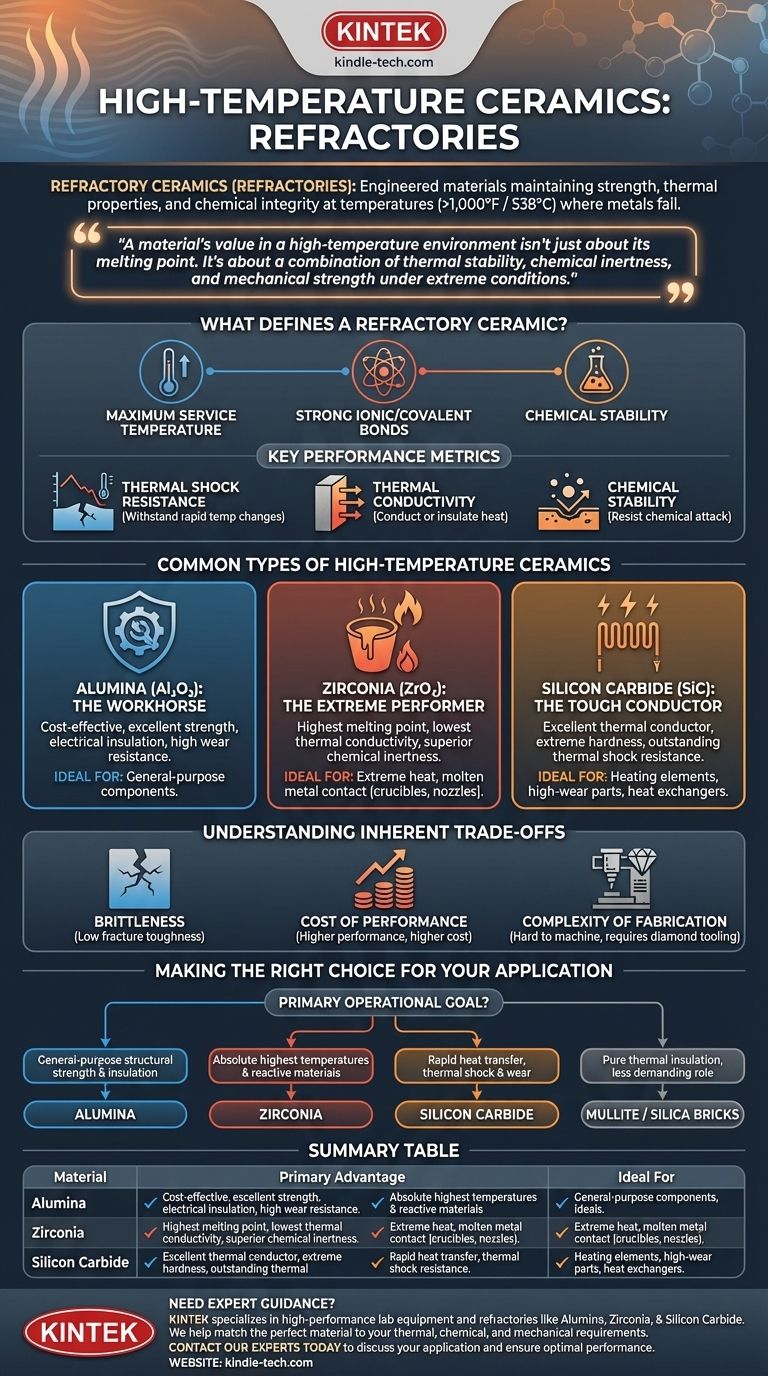The technical term for ceramics that can withstand high temperatures is refractory ceramics, often shortened to refractories. These materials are specifically engineered to maintain their strength, thermal properties, and chemical integrity at temperatures where most metals would weaken, melt, or oxidize.
The key insight is that a material's value in a high-temperature environment isn't just about its melting point. It's about a combination of thermal stability, chemical inertness, and mechanical strength under extreme operating conditions.

What Defines a Refractory Ceramic?
The term "refractory" implies more than just heat resistance. It signifies a class of materials designed to perform reliably in demanding thermal and chemical environments, typically above 1,000°F (538°C).
Beyond a High Melting Point
While a high melting point is a prerequisite, the true measure of a refractory is its maximum service temperature. This is the highest temperature at which the material can operate continuously without degrading, deforming under load, or losing its critical properties.
The Role of Chemical Composition
The exceptional stability of these ceramics comes from their strong ionic and covalent atomic bonds. Most are based on metal oxides, carbides, or nitrides.
Common examples include:
- Alumina (Aluminum Oxide, Al₂O₃)
- Zirconia (Zirconium Dioxide, ZrO₂)
- Silica (Silicon Dioxide, SiO₂)
- Silicon Carbide (SiC)
These compositions are inherently stable and have very little desire to react with other elements, even at high temperatures.
Key Performance Metrics
Selecting the right refractory involves looking beyond a single temperature rating. Several interconnected properties determine its suitability for a specific application.
- Thermal Shock Resistance: The ability to withstand rapid temperature changes without cracking. This is critical for components like crucibles that are heated and cooled quickly.
- Thermal Conductivity: This determines how well the material conducts or insulates against heat. A furnace lining requires a low-conductivity insulator, while a heating element needs high conductivity.
- Chemical Stability: The material must resist chemical attack from its environment, whether from molten metals, corrosive gases, or furnace slags.
Common Types of High-Temperature Ceramics
Different compositions offer distinct advantages, making them suitable for different industrial and scientific applications.
Alumina (Al₂O₃): The Workhorse
Alumina is one of the most widely used and cost-effective refractory ceramics. It offers excellent high-temperature strength, good electrical insulation, and high wear resistance. It is often the default choice unless a specific property, like extreme thermal shock resistance, is required.
Zirconia (ZrO₂): The Extreme Performer
Zirconia has one of the highest melting points and lowest thermal conductivities among common ceramics. This makes it an exceptional thermal barrier and ideal for applications involving contact with molten metals, such as crucibles and nozzles for continuous casting of steel.
Silicon Carbide (SiC): The Tough Conductor
Unlike most oxide ceramics, Silicon Carbide is an excellent thermal conductor. This property, combined with its extreme hardness and outstanding thermal shock resistance, makes it perfect for heating elements, heat exchangers, and high-wear components like pump seals.
Understanding the Inherent Trade-offs
While refractories offer incredible performance, they are not without limitations. Acknowledging these trade-offs is crucial for successful design and implementation.
The Challenge of Brittleness
The primary drawback of nearly all ceramics is their brittleness. They have very low fracture toughness, meaning they can fail suddenly and catastrophically when subjected to impact or tensile stress, with little to no plastic deformation.
The Cost of Performance
As a general rule, higher performance translates to higher cost. High-purity raw materials and the energy-intensive processing required to manufacture dense, high-performance ceramics make them significantly more expensive than most metals.
The Complexity of Fabrication
Refractory ceramics are extremely hard, making them difficult and expensive to machine. Complex shapes are typically formed before the final firing (sintering) process, as post-sintering grinding requires specialized diamond tooling and is a slow, costly operation.
Making the Right Choice for Your Application
Selecting the correct material requires a clear understanding of your primary operational goal.
- If your primary focus is general-purpose structural strength and insulation at high temperatures: High-purity Alumina is almost always the most balanced and cost-effective starting point.
- If your primary focus is the absolute highest temperatures or containing reactive molten materials: Zirconia offers superior chemical inertness and a higher service temperature.
- If your primary focus is rapid heat transfer, thermal shock, or wear resistance: Silicon Carbide's unique combination of hardness and thermal conductivity makes it the ideal choice.
- If your primary focus is pure thermal insulation in a less demanding structural role: Materials like Mullite or silica-based refractory bricks often provide the most cost-effective solution.
Ultimately, choosing the right high-temperature ceramic is about matching the unique properties of the material to the specific demands of your environment.
Summary Table:
| Material | Primary Advantage | Ideal For |
|---|---|---|
| Alumina (Al₂O₃) | Cost-effective, good strength & insulation | General-purpose high-temperature components |
| Zirconia (ZrO₂) | Highest service temperature, chemical inertness | Extreme heat, molten metal contact |
| Silicon Carbide (SiC) | Excellent thermal conductivity & shock resistance | Heating elements, high-wear parts |
Need expert guidance selecting the right high-temperature ceramic for your lab?
KINTEK specializes in high-performance lab equipment and consumables, including refractory ceramics like Alumina, Zirconia, and Silicon Carbide. We can help you match the perfect material to your specific thermal, chemical, and mechanical requirements.
Contact our experts today to discuss your application and ensure optimal performance and durability.
Visual Guide

Related Products
- Silicon Carbide SiC Thermal Heating Elements for Electric Furnace
- 1700℃ Laboratory Quartz Tube Furnace with Alumina Tube Tubular Furnace
- Laboratory Muffle Oven Furnace Bottom Lifting Muffle Furnace
- Conductive Boron Nitride BN Ceramics Composite for Advanced Applications
- 1400℃ Muffle Oven Furnace for Laboratory
People Also Ask
- What is a silicon carbide heating element? Unlock Extreme Heat for Industrial Processes
- What is SiC melting point? Discover the Extreme Thermal Stability of Silicon Carbide
- What is SiC elements? The Ultimate High-Temperature Heating Solution
- What are silicon carbide heating elements used for? Reliable High-Temp Heating for Industrial Processes
- What kind of metal is used in heating elements? A Guide to Materials for Every Temperature & Atmosphere



















